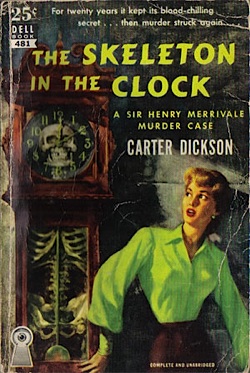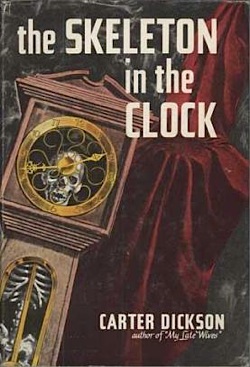I need to start this essay with two apologies, one for the embarrassingly long hiatus since my last essay, and one for the fact that this essay is not about Ellery Queen.
1. I have been struggling with a variety of health problems since I broke my ankle last year. (I plan to celebrate the one-year anniversary by NOT BREAKING ANYTHING.) I don’t want to go into boring detail, but it’s been a year since I had an ordinary, restful night’s sleep without the use of prescription drugs. Ergo, it has gotten harder and harder to write (or to do much of anything else); these posts are one of the things that have suffered, and I apologize for that.
2. And I need to apologize for the fact that this essay is not about Ellery Queen. I’m not done writing about EQ by any means, but the mystery that’s been exercising my mind recently is The Skeleton in the Clock (1948) by a different Golden Age pseudonymous writer, Carter Dickson.
Carter Dickson is the transparent pseudonym of John Dickson Carr, one of the most prolific authors of the Golden Age. Carr’s principal detective was Gideon Fell, immense and jovial and based on G. K. Chesterton (as is Neil Gaiman’s splendid anthropomorphic Fiddler’s Green); he used the Carter Dickson pseudonym to write about Sir Henry Merrivale.
I need to enter some caveats. The books featuring H.M., or the “Old Man,” as he calls himself, are allegedly “funny” mysteries. I don’t find them funny, but for some reason which I cannot explain I find them immensely comforting. I also find H.M. one of Carr’s most interesting characters—much more interesting than Fell. H.M. is a baronet who talks like a cartoon working class man, who roars and blusters and makes an ass of himself, who is a consummate bloody-minded jerk—and yet, behind that facade, Carr suggests, though never quite shows, an entirely different person. In The Red Widow Murders (1935), he writes, “Tairlaine could not keep pace with the man’s enormous intellectual restlessness, which was in contrast to the Chinese-image woodenness of his face, and seemed at first to occupy itself with what looked like children’s puzzles” (TRWM, p. 161). For me, that sums up H.M. in a nutshell: children’s games used as a stalking horse for genius.
The other important caveat is about Carr himself. I enjoy his mysteries, but they will not be everyone’s cup of tea. He is a very formulaic writer; there is always an ingenue and a young male lead to provide foreground distraction, and since Carr is a specialist in the locked-room mystery, the situations are often entirely improbable, and so intricate that Carr himself frequently loses track of all the threads—but that’s okay, because so do I.
Carr is also misogynist, egregiously so in some books, and he writes young women very badly. This contrasts oddly with the fact that his middle-aged and old women are frequently fascinating characters, and their horrible flaws are never blamed on them being women (e.g., Estelle Barclay in The House at Satan’s Elbow (1965) and Lady Brayle in The Skeleton in the Clock). Also, when Carr forgets himself, he can write young women who are human beings; Brenda White in The Problem of the Wire Cage (1939) is my favorite Carr ingenue, because she’s proof he can do it, but she makes his habitual stance—that women are simply incomprehensible and will always tell lies and should be indulged and pampered, but never taken seriously—all the more frustrating.
 Which brings us to The Skeleton in the Clock, which is positively schizophrenic in its portrayals of female characters, and which also, surely, has one of the strangest, and most strangely lavish, red herrings in the history of detective fiction. And which, honestly, is kind of a mess.
Which brings us to The Skeleton in the Clock, which is positively schizophrenic in its portrayals of female characters, and which also, surely, has one of the strangest, and most strangely lavish, red herrings in the history of detective fiction. And which, honestly, is kind of a mess.
It’s hard to know where to start, so I’m going to start with the red herring, which is the thing about the book that’s so darn weird I wanted to write an essay about it. Carr has a fondness for inventing prisons—Hag’s Nook (1933) is all about the imaginary and incredibly Gothic Chaterham Prison and its hereditary wardens, the Starberths—and for The Skeleton in the Clock, he invents Pentecost Prison (bonus points for the name), which got requisitioned in World War II to serve as an archive and is now (1948) deserted except for bales and bales of paper. Pentecost was also a prison at which executions took place, and our obligatory male lead (Carr writes in the Conan Doyle tradition; the detective is never the point of view character, so he has a rotating cast of disposable young men), Martin Drake, gets into a bet about spending the night in the execution shed. That’s the book’s A plot. The B plot is H.M.’s feud with Jenny’s realistically horrible grandmother, and then there’s the mystery, which is the puzzle of who murdered Sir George Fleet twenty years ago, and how did they manage it?
Much is made of Pentecost Prison and its atmosphere and history and the terrible murderers who were executed there, and much is made of the bet between Drake and his bete-noire, John Stannard, which provides most of the foreground action and conflict of the A plot until a new murder occurs. The bet, in fact, seems to create the perfect opportunity for murder, since it involves Stannard and Drake spending the night in the prison, one in the execution shed and one outside it. But the function of the prison is represented exactly on the morning following the bet, when Martin Drake is distracted by the prison’s alarm bell ringing long enough for the murderer to push him off a roof. The prison is a vast, gaudy red herring, and even though a murder takes place there, it has nothing at all to do with the prison.
Red herrings are, of course, indiginous fauna in detective fiction, but I can’t think of another that takes up so much of a novel’s attention. One of the things I really like about The Skeleton in the Clock is the way prisons are thematic, that aside from Pentecost Prison looming cold and gray over the whole thing, both of the houses in the novel, Brayle Manor and Fleet House, are also prisons, one imprisoning the ingenue and one imprisoning (ineffectively) the murderer.
(The murderer, I should remark, is a bit of a failure, due to the book’s being written in 1948 by someone who had no real understanding of either psychopaths or child murderers—or the possiblity that those two terms are not synonymous. So the murder is brilliant, as Carr’s murders mostly are, but the murderer not so much.)
Jenny West, the ingenue of The Skeleton in the Clock, is my second favorite Carr ingenue. She is not quite as deeply realized as Brenda White, but she has dignity and a sense of humor and it’s possible to believe that she exists when Martin Drake isn’t there. In all ways, she contrasts with the other young woman in the book, Ruth Callice.
The narrative goes out of its way to establish Ruth as “nice,” for which you should actually read “unprincipled liar with a God-complex.” Ruth seems to be doing everything in her power to sabotage Martin and Jenny’s burgeoning relationship, including a fantastically unconvincing seduction scene, in which Ruth says, “Suppose you kiss me,” and Martin does (TSitC 99). Yet, because Ruth is “nice,” there is no fallout from this encounter; it does not change Martin’s opinion of her, or the narrative’s opinion of her, and we’re supposed to be pleased that she gets a happy ending. Ruth Callice’s behavior throughout the novel makes no sense—you could not possibly rewrite The Skeleton in the Clock from her point of view—and the narrative’s cues about how we are to read her are directly at odds with her actions.
The problem with The Skeleton in the Clock, at its simplest, is that the parts don’t fit together into a commensurate whole. (In other words, Ruth Callice functions as a kind of unintentional metonymy for the book.) The A plot, the B plot, and the mystery intersect each other, and the B plot would, I think, be functional with EITHER the A plot OR the mystery (I still wouldn’t find it particularly funny, but that, as I said, doesn’t bother me). But it can’t hold the two of them together on its own, and thus the A plot, as Gothic and obtrusive as the helmet that crushes Conrad in The Castle of Otranto, is my favorite red herring in detective fiction.
Sarah Monette has two cats who say they know what to do with red herrings.










